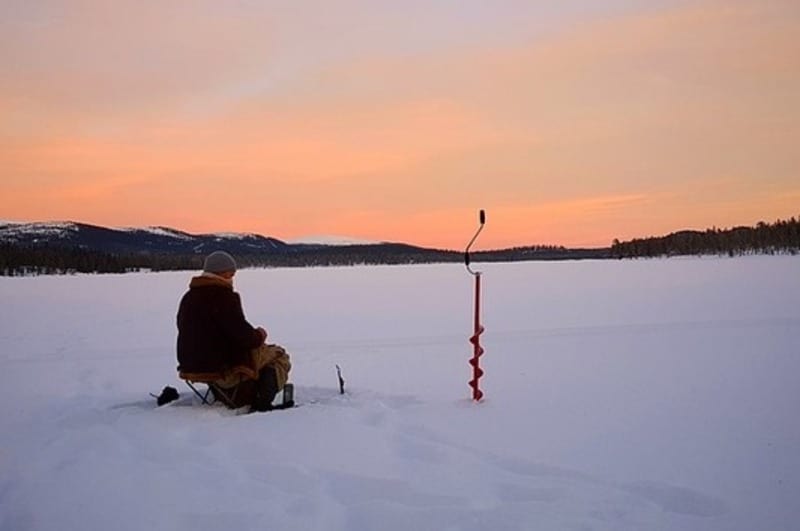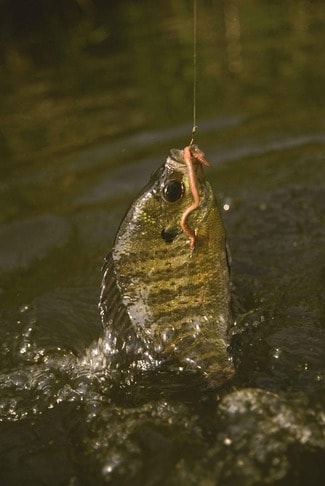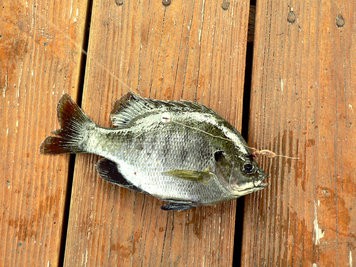Bluegill Fishing in Cold Weather (All Seasons) Full Guide
Leave a comment after this article and let’s talk more about bluegill fishing. I’d love to read your feedback.
In colder water temperatures, bluegill tend to be less active and may bite less frequently, as their metabolism slows down. However, they can still be caught during cold periods, especially in deeper, warmer pockets of water where they seek refuge.
It is well documented that bluegill consume less in colder water than summer. During winter especially, their metabolism slows down and their movements correspond. Check out this helpful guide on how water temperatures impact bluegills.

The most important concept you need to understand here is that bluegill respond to temperature changes, not to temperatures themselves. What I mean is even during the winter, a 5° temperature increase can turn the feeding switch on.
Likewise, a degree or two drop in temperature can completely shut them down. This phenomenon occurs all year long including the summer. Remember it is more important to focus on changes in temperature than it is actual temperature.
Table of Contents
Bluegill Fishing in Cold Weather
Is Bluegill Fishing Good in Cold Weather?
Bluegill fishing in cold weather can be productive, but it is more challenging than in warmer months. As the temperature drops, bluegills move to deeper water and become less active, making them harder to find and catch. Anglers need to use slow and subtle fishing methods with smaller baits and lures.
Cold weather fishing can still result in good catches, especially in areas where the water doesn’t freeze and bluegills gather in deeper, warmer areas. Success in cold weather requires patience and adjusting to the changed behavior of bluegills.
Note: Northern Waters refers to waters that freeze over/permit ice fishing in winter; Southern waters typically don’t afford ice fishing opportunities.
Click here for a complete breakdown of weather impacts on fishing for bluegill. You may also be interested in an article we wrote on the best times and seasons for bluegill fishing.
Late Fall – Northern Waters
Late fall northern bluegills really start to slow down in feeding behavior as the days grow shorter and colder. Like I mentioned earlier, decreases in water temperature bring about a progressive slowing of feeding. The general direction of activity will go down as winter approaches.
That said, each day, there will be significant increases in water temperature (typically warmest in the early-to-mid afternoon). Even though the weather is generally getting colder, those mini-warming cycles that occur daily will spike feeding.
These are the windows I recommend targeting bluegills. Bluegills are still very eager to pack on weight in preparation for the lean winter. Terrestrial insects like grasshoppers and mosquitos are no longer an option. Instead, focus on presenting them with minnows.
Worms, mealworms, and waxies will work now too. Avoid fishing in shallow water as this water will be colder than deeper water which better holds its summer warmth. Bluegill can often be found in water 20 feet or deeper as winter approaches.
Late Fall – Southern Waters

You folks in the summer have it a little easier since terrestrial insects can still be seen landing on the water. Feeding will certainly still slow down though even if your water never gets as cold as it does in the north.
As with northern bluegills, you’ll want to use live bait to target big bluegills in the warmest periods of the day. Typically, these warmer spikes in temperature occur in the afternoon.
Make sure you are on the water and in position to take advantage of these increases in water temperature.
Because the overall water temperature still isn’t too cool yet, you will enjoy more active bites longer than northern folks will.
During late fall you can find bluegill transitioning between shallow to medium-depth water.
Some may even start venturing into deep water as they follow the warmer water and food base.
The building block of the food chain is zooplankton and these microorganisms will shift down in the water column as they likewise follow that warmer water.
Winter (Ice Cover)
My favorite activity on the water is ice fishing. I grew up in Pennsylvania so this is my time to live. Bluegill can be readily caught through the ice. Focus your fishing efforts to afternoons on protected corners of a lake separate from the main body. I think coves and inlets are great places to focus on.
If you are lucky enough to see cover sticking above the ice, like the branch of a submerged log, fish that area first. Panfish of all varieties will huddle here.
You can catch 20+ bluegills in a short period of time off one good piece of cover. These, however, will be on the smaller size. To catch larger bluegills, focus on deeper underwater cover and rises.
Large bluegills tend to be a little less social than their smaller counterparts. You may only have 3 big bluegills together but they are worth targeting. Jig mealworms, waxies, or just green-head jigs for great results. Again though, fish the warmer parts of the day.
Winter Non-Ice Cover
It doesn’t matter if you are fishing in the south where lakes don’t freeze over or in the north during a period of time where there is no ice cover, this section applies equally to both.
Fish slowly in water 10-20 feet deep. Focus on cover like timber or boulders. Live bait and small jigs are the best option.
Fishfinder electronics can be your ally to locate these structures and corresponding bluegill schools nearby.
Early Spring – Northern Waters

Early spring for northern lakes is a transitional time. Ice is starting to melt and shrink away. The shallowest water will become thawed first and the ice cube will gradually shrink to nothing.
It is far too dangerous to even think about ice fishing now so you are forced to either fish shallow where there is no ice or wait a week until the ice is gone.
My advice is just to wait since bluegills will still be deeper than you can fish from shore. As water temperatures begin to rise, bluegills will quickly head into shallow water where the water is now warm enough to support them feeding.
Early Spring – Southern Waters
In southern waters, you may experience faster shallow migration of bream. You can cast worms or minnows from shore or by boat with great success.
With each passing week, the bite will get hotter. That is until the spawn in late spring at which point fishing can slow way down. During early spring when the water is still pretty cool, fish live bait or even slowly retrieved lures.
Winter Bluegill Fishing
Bluegill fishing in winter requires a strategic approach due to the fish’s reduced activity in cold water. Anglers should target deeper waters where bluegills retreat for warmth, often near structures like submerged logs or weed beds. Using small jigs or live bait like waxworms can be effective, as bluegills prefer smaller, easily digestible meals in winter. Light tackle and sensitive rods are essential for detecting the subtle bites typical of bluegills during this season.
| Factor | Recommendation to Catch Winter Bluegill |
|---|---|
| Target Depth | Deeper waters, near structures like submerged logs or weed beds |
| Preferred Bait | Small jigs, live bait like waxworms or small minnows |
| Tackle Recommendation | Light tackle with sensitive rods for subtle bite detection |
| Bite Detection | Subtle, often requiring keen attention and a soft touch |
| Fishing Technique | Slow and steady retrieval, frequent bait checks and adjustments |
Do bluegill bite in winter?
Bluegill do bite in the winter, but their activity levels may decrease compared to warmer months. Bluegills can be caught during winter by adjusting fishing techniques and targeting deeper water where they seek refuge from colder temperatures. Using smaller baits and fishing slower can increase the chances of enticing bluegill bites during the winter season.
How Deep Do Bluegill Go in Winter
| Water Temperature Range | Typical Depth | Behavior |
|---|---|---|
| Below 40°F (4°C) | 20-30 feet (6-9 meters) | Very lethargic, staying in deeper, warmer waters |
| 40°F – 50°F (4°C – 10°C) | 10-20 feet (3-6 meters) | Moderately active, moving to mid-depths for feeding |
| Above 50°F (10°C) | Less than 10 feet (3 meters) | More active, occasionally moving to shallower areas for food |
Bluegill tend to go deeper in winter, seeking warmer water and food sources. The depth bluegill go in winter can vary depending on the temperature, but they often inhabit depths of 15 to 30 feet. They do this to avoid freezing temperatures and find suitable conditions for survival during the colder months.
Where Bluegill Go in Winter
Bluegill typically go into deeper water during the winter months, seeking areas with more stable temperatures. They often congregate in schools near submerged structures or drop-offs, where the water is deeper and provides more consistent conditions. It is common for bluegill to bury themselves in the mud or remain relatively inactive during colder periods.
| Water Body Type | Winter Location | Behavior |
|---|---|---|
| Lakes | Deeper areas away from shore, near underwater structures or warm water inflows | Form schools in stable, deeper areas for warmth and protection |
| Ponds | Deepest parts of the pond, often near the bottom | Less mobile, staying near the bottom where the water is slightly warmer |
| Rivers/Streams | Slower, deeper sections of the river, away from strong currents | Seek areas with less current and more stable water temperatures |
Winter Diet
In winter, bluegill’s diet becomes more limited due to reduced metabolism and decreased availability of food sources. They primarily consume small invertebrates like insect larvae, tiny crustaceans, and zooplankton, which they find in the deeper, warmer parts of water bodies where they reside during colder months. The slow-moving nature of these food sources aligns with the bluegill’s reduced activity level in winter, requiring less energy to catch.
6 Tips to Catch More Cold Weather Bream
1. Use Live Bait
When the water is chilly, there is no better way to fish panfish than with live bait. Select naturally occurring bait that you’d expect to find in the water now. Grasshoppers and flies are largely non-existent in the cooler months.
Minnows are your best option. Select minnows in the 1-2 inch range. Do not select any minnows larger since they will not fit in the small mouths of bluegills. You can also get away with meal worms, red worms, and wax worms now. In fact, you could have great success in the right location.
2. Wait for Daily Increases in Temperature
Bluegills respond directly to immediate temperature fluctuations and less to seasonal trends. By this, I mean they’ll respond directly to a 5° increase/decrease in temperature over a couple of hours way more than they’ll respond to a 30° difference between seasons.
Pay attention to any upcoming cold or warm fronts and also to what time of day will be warmest. Hit those warm windows hardest. Fishing will be slowest in the early morning when the water is at its coldest. Fish these mini temperature variations for better bluegill action.
3. Fish Slow, Deliberate
Don’t waste your time fishing fast in cold water. You are way better off fishing slow. This means using lively live bait and allowing a minnow to swim around and fish itself. It also means slowly jigging over drop-offs.
Bluegill are less active in cold water so fish them slower. Avoid lures that demand speedy retrieves. As I said, a small minnow cannot be beaten. Small minnows also will only be consumed by big bluegills so you can ensure you’ll only get bit by large ones.
4. Avoid Shallow Water
During cold months, shallow water is the coldest water in the lake. Instead, focus fishing in medium-to-deep water. Deeper water actually is warmer typically than shallow water during winter.
Bluegill will move into 10+ feet water as the fall leaves drop and the temperatures start to drop. Don’t waste your time fishing shallow. You may find some bluegills in shallow water but the colder water won’t promote a feeding response from them. Instead, focus on the bluegills out deep that will eat.
5. Target Quantity or Target Size
When fishing cold water bluegills, you can choose 2 different categories of fish to target: abundant small ones or big loners. Small bluegills will stack on each other over prominent cover for shelter during winter.
These smaller fish are easy to catch and can provide exciting, non-stop action when the bite is on. But you won’t find many if any large bluegills hanging out with these shrimps. To catch big bluegills during winter, instead, focus on the subtle deeper cover like weeds or rocks. You may only find a fish or two at these locations, but they won’t be small.
6. Fish Deep
Don’t waste your time fishing shallow in cold water. Most fish species, bluegills included, follow warm water where it goes. During the winter, warmer water is found in the deepest parts of the lake.
Now I’m not saying to fish down 100 feet for bluegills. You won’t have any luck finding them. Instead, fish down 20-30 feet. Bluegill can often be found in numbers at these deeper depths.
Frequently Asked Questions
When do bluegill stop biting?
Bluegill typically stop biting in the late fall or early winter, when water temperatures drop below 50 degrees Fahrenheit. This drop in temperature slows down their metabolism and makes them less active. However, it can vary depending on the region and specific conditions of the waterbody.
